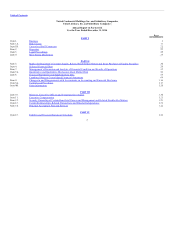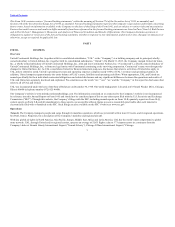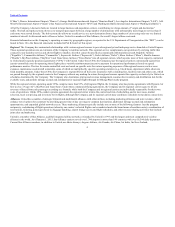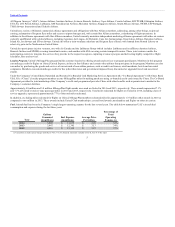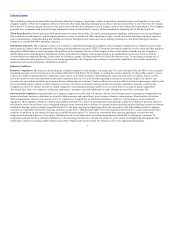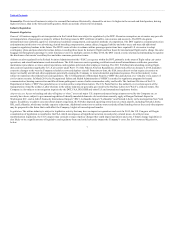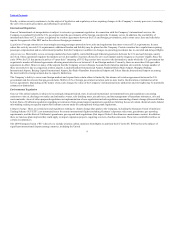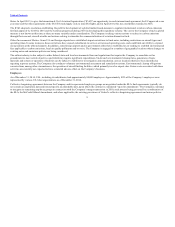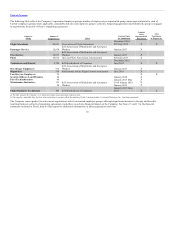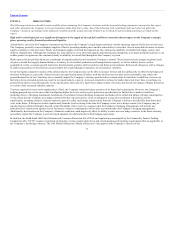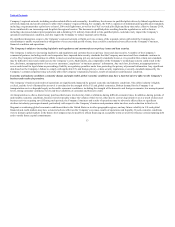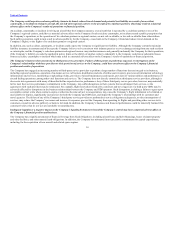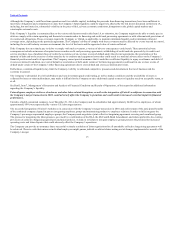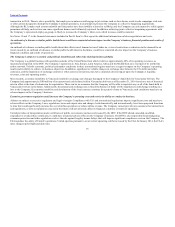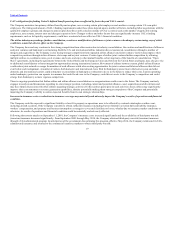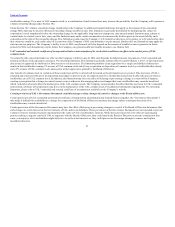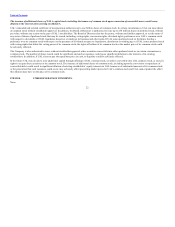United Airlines 2014 Annual Report Download - page 12
Download and view the complete annual report
Please find page 12 of the 2014 United Airlines annual report below. You can navigate through the pages in the report by either clicking on the pages listed below, or by using the keyword search tool below to find specific information within the annual report.
Table of Contents
CFTC’s end-user exception, which permits the Company as a non-financial end user of derivatives to hedge commercial risk and be exempt from the CFTC
mandatory clearing requirements. However, several of the Company’s hedge counterparties are also subject to these requirements, which may raise the
counterparties’ costs. Those increased costs may in turn be passed on to the Company, resulting in increased transaction costs to execute hedge contracts and
lower credit thresholds to post collateral (margin).
See Note 10 to the financial statements included in Part II, Item 8 of this report for additional information on the Company’s hedging programs.
Terrorist attacks or international hostilities, or the fear of terrorist attacks or hostilities, even if not made directly on the airline industry, could negatively
affect the Company and the airline industry.
The terrorist attacks on September 11, 2001 involving commercial aircraft severely and adversely impacted the Company’s financial condition and results of
operations, as well as the prospects for the airline industry. Among the effects experienced from the September 11, 2001 terrorist attacks were substantial
flight disruption costs caused by the FAA-imposed temporary grounding of the U.S. airline industry’s fleet, significantly increased security costs and
associated passenger inconvenience, increased insurance costs, substantially higher ticket refunds and significantly decreased traffic and passenger revenue.
Additional terrorist attacks, even if not made directly on the airline industry, or the fear of or the precautions taken in anticipation of such attacks (including
elevated national threat warnings or selective cancellation or redirection of flights) could materially and adversely affect the Company and the airline
industry. Wars and other international hostilities could also have a material adverse impact on the Company’s financial condition, liquidity and results of
operations. The Company’s financial resources may not be sufficient to absorb the adverse effects of any future terrorist attacks or other international
hostilities.
The Company relies heavily on technology and automated systems to operate its business and any significant failure or disruption of the technology or
these systems could materially harm its business.
The Company depends on automated systems and technology to operate its business, including computerized airline reservation systems, flight operations
systems, revenue management systems, accounting systems, telecommunication systems and commercial websites, including www.united.com. United’s
website and other automated systems must be able to accommodate a high volume of traffic, maintain secure information and deliver important flight and
schedule information, as well as process critical financial transactions. These systems could suffer substantial or repeated disruptions due to various events,
some of which are beyond the Company’s control, including natural disasters, power failures, terrorist attacks, equipment or software failures, computer
viruses or cyber security attacks. Substantial or repeated systems failures or disruptions, including failures or disruptions related to the Company’s complex
integration of systems, could reduce the attractiveness of the Company’s services versus those of its competitors, materially impair its ability to market its
services and operate its flights, result in the unauthorized release of confidential or otherwise protected information, result in increased costs, lost revenue and
the loss or compromise of important data, and may adversely affect the Company’s business, results of operations and financial condition.
Disruptions to the Company’s regional network and United Express flights provided by third-party regional carriers could adversely affect the Company’s
operations and financial condition.
The Company has contractual relationships with various regional carriers to provide regional jet and turboprop service branded as United Express. These
regional operations are an extension of the Company’s mainline network and complement the Company’s operations by carrying traffic that connects to
mainline service and allows flights to smaller cities that cannot be provided economically with mainline aircraft. The Company’s business and operations are
dependent on its regional flight network, with regional capacity accounting for approximately 13% of the Company’s total as of December 31, 2014.
Although the Company has agreements with its regional carriers that include contractually agreed performance metrics, the Company does not control the
operations of these carriers. A number of factors may impact the
12


